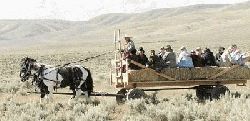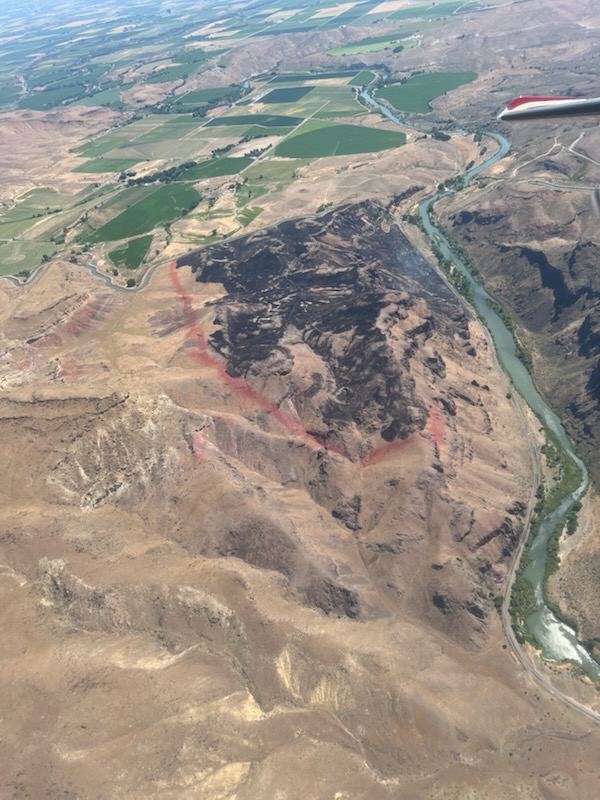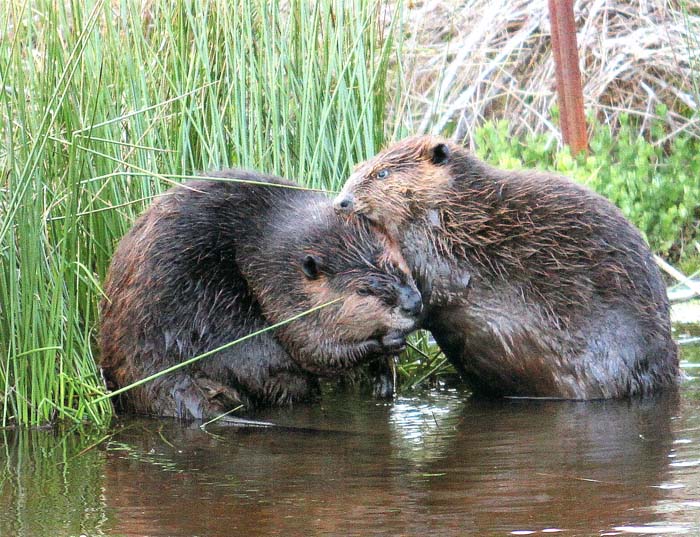Kennedy Wagon Train reunion
Published 12:00 am Tuesday, June 13, 2006

- Descendants of Oregon Trail pioneers who joined the Kennedy wagon train in 1862 were treated to a wagon ride along the very ruts walked by their relatives. (Baker City Herald/Lisa Britton).
By LISA BRITTON
Barb Clark sums up the entire Kennedy wagon train reunion when she meets Marjorie Miles:
andquot;We’re related somehow.andquot;
Then follows a verbal blizzard of surnames and family trees that baffles innocent bystanders but makes perfect sense to these two who are connected by a pioneer story set in 1862.
andquot;I keep running into fourth cousins I’ve never met before,andquot; Everell Cummins said with a laugh as he signed copies of his book, andquot;Train of Innocents, The Story of the Kennedy Train.andquot;
About 125 Oregon Trail descendants congregated in Baker City last weekend to celebrate the Kennedy wagon train that departed from Fremont, Iowa, on April 24, 1862, and set out on the Oregon Trail. Their destination was the Walla Walla valley.
The reunion was organized by Donna Heikkila, who lives in Longwood, Fla., and Jayne McCarley, who lives in Vancouver, Wash.
The two met in 2000 while researching their family histories on the Internet.
They kept in touch, swapping information about the wagon train that connected them, and in 2002 Heikkila decided to see if they could wrangle up enough descendants for a reunion.
Her idea was prompted by a trip she took to Wyoming to find the grave of Elizabeth Paul who died along the trail. She was the wife of Thomas Paul, who was the brother of Heikkila’s great-great-grandfather.
(The andquot;greatsandquot; get a little more confusing the deeper you dig into the past.)
After that trip, Heikkila put out a call on the Internet to anyone interested in a reunion. The responses poured in, and the first-ever Kennedy Wagon Trail of 1862 reunion was set for June in Baker City.
Registration on Friday night brought 125 descendants. However, consider this: The Kennedy train started with 12 wagons, soon grew to 52 (with more than 200 pioneers) and that number even climbed as high as 80, as reported in Cummins’ book, which is based on diaries and research.
That’s a lot of family trees, and a lot of people who can trace their heritage back to this particular wagon train.
andquot;We didn’t touch the tip of the iceberg,andquot; Heikkila said of the number of descendants.
The wagon train of 1862
The train was led by Captain John Knox Kennedy, who had already been West twice before to California in 1849 for the gold rush and again in 1859 when he spent a winter with a cousin, Robert Porter Kennedy, in Walla Walla County near present-day Waitsburg, Wash.
andquot;That apparently was influential in his decision (to head West),andquot; said Elaine Andersen, a descendant of Robert P. Kennedy whose name tag described her as an andquot;honorary member of the 1862 Kennedy wagon train.andquot;
Everyone in attendance received a tag that included their name along with the names and photos of their ancestors who made the trip west with the Kennedy train.
Marjorie Ellis Miles’ name tag was almost too small to note her family ties because she is connected to eight different families by both her mother and her father who traveled with Kennedy.
Miles, 93, lives in Nampa, and one story of her Kennedy connection is included in Cummins’ book because, on July 14, 1862, a baby boy was born to E.E. and Eliza Jane Ellis, who was six months pregnant when she began the trip west.
That boy was Miles’ grandfather.
She was the guest of honor at the Kennedy reunion and, when each family gathered for photographs, she and her son David joined nearly every group.
andquot;My great-grandmother told me stories (of the trail),andquot; she said. andquot;She told all sorts of tales, but I was of an age I wasn’t smart enough to write anything down.andquot;
She did, however, help re-create the roster of the Kennedy train pioneers, and she has a pretty good understanding of the ordeal that faced those travelers.
andquot;If I’d have lived at that time, I’d never have made it out of the village,andquot; she said with a smile. andquot;They had no idea what they were getting into.andquot;
In andquot;Train of Innocents,andquot; this is the recollection of Sarah Zaring Howard 70 years after traveling from Iowa to Oregon:
andquot;The Captain had pictured to his people a pleasurable trip with camping, fishing, hunting and traveling at leisure. However things were not always what they seemed and each day brought new trials. It seemed that we were somewhat like the children of Israel when they were wandering in the desert, and some felt like faltering by the wayside but they did not turn back.andquot;
The Kennedy train faced stampedes, wagon accidents, food shortages and threats of Indian attacks.
But perhaps the most memorable event came on July 7 when Kennedy’s train came upon a group of travelers who reported that a murderer was camped in their midst. Kennedy and 20 men seized the man, who was accused of killing his mining partner and subsequently organized a jury of 12 men.
The murderer was tried, found guilty, made to dig his own grave and was executed by a firing squad of 25.
That was around 8 a.m. on July 8. In the diary of James McClung, it is reported that after the execution the Kennedy train hitched up the wagons and covered 12 miles that day.
Not much impeded their westward progress.
Headed for Walla Walla
On Sept. 18, 1862, pioneer Hamilton Scott notes the divergence of trails, andquot;one leading to Fort Walla Walla and the other to Powder River gold mines ten miles from Auburn.andquot;
Though some decided to seek their fortune at Auburn, most in the Kennedy train continued on toward Walla Walla. They arrived on Sept. 27.
Kennedy, who had been wounded in a fight with Indians at Massacre Rocks near American Falls in Idaho, claimed 160 acres in the La Grande area.
In his diary, James McClung recorded that La Grande City has andquot;five houses, one store and a blacksmith shop.andquot;
Kennedy eventually made it to Walla Walla, in 1864 or ’65, Cummins reports, and he died in 1889.
A walk in the sagebrush
Heikkila and McCarley chose Baker City because of the Oregon Trail Interpretive Center, which welcomed the visitors with gold panning and a Dutch oven lunch prepared by the Trail Tenders.
But before they toured the Interpretive Center, 88 of the descendants rose early to take a wagon ride along the very ruts where their ancestors walked mile upon dusty mile.
Ron Colton and Jim Galyen provided wagons and teams of horses to give the visitors a ride through Virtue Flat where the trail ruts are still visible.
andquot;It was great to see the actual trail our ancestors came on. See the same hills, the same sage. It makes you feel close to your family,andquot; said Sherry Scott of Lancaster, Calif., who traces her roots back to John and Mary Scott, two Kennedy train pioneers.
andquot;This is a dream come true,andquot; said Leslie Smith, another Scott descendant.
Heikkila and McCarley hope to have another Kennedy reunion in 2012, the 150th anniversary of the wagon train’s trip across the Oregon Trail.
They plan to find even more descendants for the second gathering.
andquot;That gives us six more years of research,andquot; Heikkila said with a laugh.





